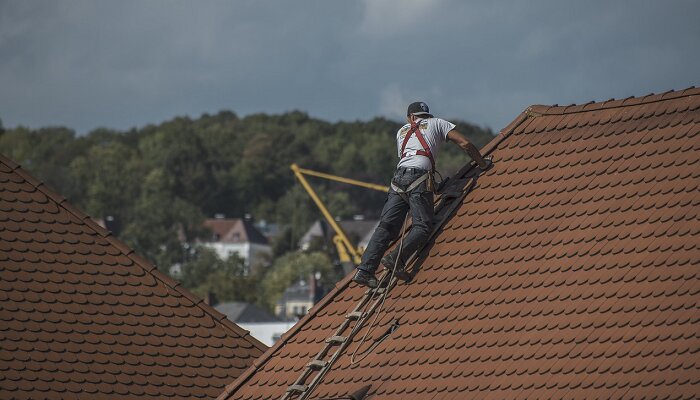The Ultimate Guide to Roof Repair and Installation: Safeguarding Your Home
As the first line of defense against weather, a sturdy trouble-free roof is essential for keeping interiors safe from water, wind, and other hazards. Knowing when to repair small issues versus completely replacing an aging roof protects both structural integrity and budget. Why a Sturdy Roof Matters The roof surface endures brutal year-round sun, rain, […] The post The Ultimate Guide to Roof Repair and Installation: Safeguarding Your Home appeared first on World Construction Today.

As the first line of defense against weather, a sturdy trouble-free roof is essential for keeping interiors safe from water, wind, and other hazards. Knowing when to repair small issues versus completely replacing an aging roof protects both structural integrity and budget.
Why a Sturdy Roof Matters
The roof surface endures brutal year-round sun, rain, hail storms, and more as your home’s protective shell. Like skin shielding organs, roofing materials seal the building envelope below safeguarding investments against:
- Water damage from leaks causes ceilings to crumble, insulation to sag, and metal frames to corrode over time
- Mold blooming underneath surfaces experiencing chronic dampness
- Energy efficiency loss and wasted money on utilities
- Compromised air quality from moisture and asbestos dust in older homes
- Rodents and insects accessing interiors through gaps
- Lightning strikes are more likely to ignite fires
Recognizing Roof Damage Signals
Catching small roof repairs early prevents major do-overs. Watch for:
- Leaks: Stains on ceilings and attic insulation plus damp peeling paint hint at water sneaking through the roof degrading materials prematurely.
- Missing/Damaged Shingles: After severe weather, do walkaround inspections ensuring shingles or tiles sit flush with no cracking.
- Granule Loss: Mineral surface granules washing away over time is normal. But large bald sections signal brittleness requiring replacement soon.
- Sagging Roof: Noticeable slopes, ridges, and uneven planes indicate rotting roof decks unable to support replacements without full teardown.
- Moss or Algae Growth: Clean off dark green or black buildup to avoid accelerating deterioration and leaks below-affected areas.
- Age: By 15-25 years, anticipate full roof replacement regardless of material. Budget accordingly as the end of lifespan approaches.
Choosing Roofing Materials
Today’s options range from classic organic looks to innovative modern technologies:
- Asphalt Shingles: The most budget-friendly option combines decent durability with easier repairs. Choose higher quality grades resisting impact damage, offering superior warranties and lengthening replacement cycles.
- Metal Roofing: Initially pricey yet extremely long-lasting, repels wildfire embers and requires little upkeep. Enhanced insulation combats noise. Broad style/color options exist.
- Tile Roofing: Exceptional protection from rain/hail coupled with aesthetic appeal for Southwest or Mediterranean homes. Long lifespan but weight demands reinforced roof decking.
- Slate Roofing: Traditional natural stone slate holds up wonderfully in harsh climates but requires robust framing support. Modern polymer slate replicates visuals at a lower cost yet lacks equal longevity.
- Wood Shakes/Shingles: Charming when new but higher maintenance and fire risk shortens lifespan significantly. Strict safety building codes apply so best for specialty homes.
The Roof Repair Process
For damaged roofs still structurally sound overall, repairs in targeted areas restore integrity affordably:
- Inspection: Have a certified roofer scrutinize the surface to map out the full scope of compromised areas needing restoration, provide an accurate quote and place tarps temporarily protecting interiors.
- Preparation: Properly set up ladders, rope off sections below the work zone, spread drop cloths interiorly, and detach/store solar panels or vents from repair locations.
- Repairs: Using materials matching existing as closely as possible, fill holes, embed new flashing, glue or nail down new shingles, seal separations, and resecure loose elements.
- Cleanup: Gather all old materials debris and leftover supplies then haul them away for proper disposal to avoid fire hazards or chemical runoff issues before removing protective tarps.
- Final Inspection: Walk the roof with the contractor ensuring repairs appear seamless and correctly executed with adequate slope/drainage renewed and no lingering holes or visible cracks jeopardizing waterproofing abilities long term. Pay and schedule the next pro inspection per warranty.
The Roof Installation Process
Eventually, aging roofs require full tear-off replacements. Key installation steps include:
- Tear-Off: Removing worn-out shingles/tiles, damaged underlayment, decorative elements, and flashing/vents prepares the bare essential framework for a new roof.
- Underlayment: Adhering new specialized water-resistant membranes (often called roofing felt) supplies essential moisture barriers protecting sheathing boards.
- Flashing: Critical metal edging pieces integrate with adjacent siding ensuring water channels are off rather than sneaking underneath new materials during storms or ice dam backups.
- New Roof: Workers methodically arrange selected shingle colors/patterns for optimal overlapping coverage with starter rows reinforced by adhesive along eaves, ridges, and rakes. Nails anchor each piece per code.
- Inspections: Throughout the process, local building inspectors verify compliance with regional codes and manufacturer specifications.
- Paperwork: Final permit approvals, warranty registrations, and invoice payments conclude the project.
Finding a Reliable Roofer
Checking credentials and reviews ensures you hire crews capable of executing roofing projects properly the first time:
- Seek Recommendations: Ask neighbors for referrals to trustworthy local companies demonstrating consistency and good workmanship over years serving your community.
- Check Credentials: Search state license databases verifying active registration, bonding, and coverage along with manufacturers’ certification statuses.
- Read Reviews: Review sites like BBB detail what past customers highlight regarding timeliness, attention to detail, responsiveness, and transparency with pricing.
- Interview Contractors: Meeting in person builds rapport while allowing discussion of options best suiting your roof’s unique style and needs.
- Request References: Ask follow-up questions surveying a mix of commercial and residential accounts on deliverables matching promises.
- Compare Quotes: Structurally compare bid breakdowns to accurately weigh aspects like material grades, site prep needs, and warranty years covered should issues later arise.
- Ask About Warranties: Beyond product guarantees, strong professional workmanship warranties prove a company stands behind replacing initial defects.
- Verify Insurance: Ensuring proper liability and workers’ compensation coverage protects homeowners legally and financially.
Trust instincts choosing roofers demonstrating experience masterfully handling repairs on homes featuring builds and architectural styles mirroring your own. For Sandwich MA area homeowners, Sandwich MA Roofers receive community endorsements for sharp contractual insights and quality roofing installations enjoyed for years after jobs are complete.
Roof Maintenance Tips
Proactive care prolongs roof lifespan significantly preventing premature leaks or damage:
- Semi-annual inspections after severe weather events catch small issues before ballooning into costly headaches.
- Regular cleaning of gutters and downspouts prevents trees/debris accumulation forcing water to pool dangerously against structures.
- Annually trim back overhanging tree branches avoiding blowdown damage during winds and excess debris accumulation.
- Carefully remove moss or algae taking root over time using gentle pressure washing to avoid granule displacement or chemical runoff environmental hazards.
- Swiftly address detected trouble spots like failed caulk seals, flashing separations, shingle lifting or surface punctures enabling moisture seepage before expenses multiply.
- For older roofs, consider preventative re-coating solutions offered by reputable companies prolonging years of worry-free performance ahead.
The Cost of Roof Work
Many variables influence overall price:
- Larger/complex roofs cost more in materials and labor hours to complete full repairs or installs.
- Premium architectural grades and natural slate/copper materials show price tags exponentially higher than basic asphalt shingles.
- Re-sheeting rotting plywood decking or tackling structural reinforcements soffits, ridges, and chimneys adds expenses.
- Insurance companies dictate regional hourly labor reimbursement rates impacting billing costs.
Building relationships with reputable local roofers ensures access to early condition assessments, warranty coverage, and maintenance care protecting home functionality and market values over time.
Conclusion
Recognizing common roof damage warning signs allows swift repairs preventing secondary destruction from unchecked leakage. When replacement becomes necessary, modern roofing materials offer durability, efficiency, and styles suiting diverse home architecture. With proper licensing, insurance, and positive community track records, skilled local roofing contractors tackle installations and emergency repairs protecting what lies beneath. Schedule periodic walkthroughs after extreme weather and keep debris cleared allowing unobstructed drainage. Take proactive preservation steps now and safeguard major investments through lasting roof integrity.
The post The Ultimate Guide to Roof Repair and Installation: Safeguarding Your Home appeared first on World Construction Today.

 machineryasia
machineryasia 








